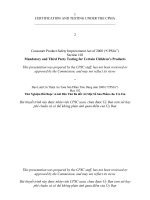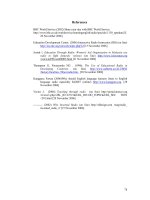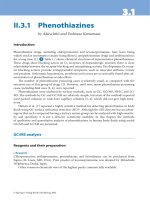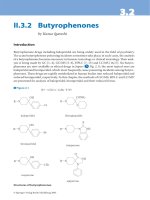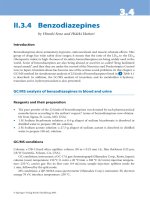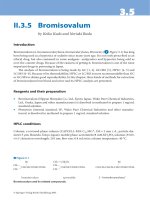Tài liệu Complementary and Alternative Medicine and Multiple Sclerosis Second Edition pdf
Bạn đang xem bản rút gọn của tài liệu. Xem và tải ngay bản đầy đủ của tài liệu tại đây (921.88 KB, 304 trang )
Complementary and Alternative
Medicine and Multiple Sclerosis
Second Edition
This page intentionally left blank
Complementary and Alternative
Medicine and Multiple Sclerosis
Second Edition
Allen C. Bowling, M.D., Ph.D.
Medical Director
The Rocky Mountain Multiple Sclerosis Center
Englewood, Colorado
and
Clinical Associate Professor of Neurology
University of Colorado at Denver and Health Sciences Center
Denver, Colorado
Demos Medical Publishing, LLC, 386 Park Avenue South, New York, New York 10016
Visit our website at www.demosmedpub.com
© 2007 by Demos Medical Publishing, LLC. All rights reserved. This book is protected
by copyright. No part of it may be reproduced, stored in a retrieval system, or transmit-
ted in any form or by any means, electronic, mechanical, photocopying, recording, or oth-
erwise, without the prior written permission of the publisher.
The first edition of this book was published in 2001 under the title
Alternative Medicine and Multiple Sclerosis.
Library of Congress Cataloging-in-Publication Data
Bowling, Allen C.
Complementary and alternative medicine and multiple sclerosis
Allen C. Bowling—2nd ed.
p. ; cm.
Rev. ed. of: Alternative medicine and multiple sclerosis. c2001.
Includes bibliographical references and index.
ISBN-13: 978-1-932603-54-5 (pbk. : alk. paper)
ISBN-10: 1-932603-54-9 (pbk. : alk. paper)
1. Multiple sclerosis—Alternative treatment. I. Bowling, Allen C.
Alternative medicine and multiple sclerosis. II. Title.
[DNLM: 1. Multiple Sclerosis—therapy. 2. Complementary
Therapies. WL 360 B787a 2007]
RC377.B6 2007
616.8'3406—dc22
2006026764
Manufactured in the United States of America
06 07 08 09 10 54321
Special discounts on bulk quantities of Demos Medical Publishing books are available
to corporations, professional associations, pharmaceutical companies, health care
organizations, and other qualifying groups. For details, please contact:
Special Sales Department
Demos Medical Publishing
386 Park Avenue South, Suite 301
New York, NY 10016
Phone: 800-532-8663, 212-683-0072
Fax: 212-683-0118
Email:
To my wife, Diana
This page intentionally left blank
Contents
Foreword by Alan J. Thompson ix
Preface xi
Organization of Chapters and Reading Sequence xiii
Acknowledgments xv
Part 1 Complementary and Alternative Medicine
Chapter 1: Complementary and Alternative Medicine (CAM) 3
Chapter 2: Placebos and Psychoneuroimmunology 16
Chapter 3: Important Precautions About Complementary
and Alternative Medicine and MS 22
Part 2 Types of Therapy
Chapter 4: Acupuncture and Traditional Chinese Medicine 29
Chapter 5: Allergies 40
Chapter 6: Aromatherapy 43
Chapter 7: Aspartame 47
Chapter 8: Ayurveda 50
Chapter 9: Bee Venom Therapy and Other Forms of Apitherapy 55
Chapter 10: Biofeedback 62
Chapter 11: Candida Treatment 66
Chapter 12: Chelation Therapy 68
Chapter 13: Chiropractic Medicine 70
Chapter 14: Colon Therapy, Detoxification, and Enemas 74
Chapter 15: Cooling Therapy 76
Chapter 16: Craniosacral Therapy 80
Chapter 17: Dental Amalgam Removal 83
Chapter 18: Diets and Fatty-Acid Supplements 87
Chapter 19: Enzyme Therapy 106
Chapter 20: Exercise 110
vii
Chapter 21: Feldenkrais 115
Chapter 22: Guided Imagery 117
Chapter 23: Herbs 120
Chapter 24: Hippotherapy and Therapeutic Horseback Riding 146
Chapter 25: Homeopathy 150
Chapter 26: Hyperbaric Oxygen 156
Chapter 27: Hypnosis 159
Chapter 28: Low-Dose Naltrexone (LDN) 163
Chapter 29: Magnets and Electromagnetic Therapy 165
Chapter 30: Marijuana 170
Chapter 31: Massage 174
Chapter 32: Meditation 178
Chapter 33: Music Therapy 182
Chapter 34: Pets 185
Chapter 35: Pilates Method and the Physicalmind Method 188
Chapter 36: Prayer and Spirituality 190
Chapter 37: Prokarin 195
Chapter 38: Reflexology 198
Chapter 39: T’ai Chi 201
Chapter 40: Therapeutic Touch 204
Chapter 41: Toxins 207
Chapter 42: Tragerwork 209
Chapter 43: Vitamins, Minerals, and Other
Nonherbal Supplements 212
Chapter 44: Yoga 240
Part 3 A Five-Step Approach: Integrating Conventional
and Unconventional Medicine
Appendix: Summary of the Effects of Popular
Dietary Supplements 263
References 267
Index 277
viii Contents
Foreword
Few areas in medicine raise as much controversy and debate as the use
of the wide range of interventions contained under the banner heading of
complementary and alternative medicine (CAM). However, it is important
from the outset to appreciate that many approaches are grouped under this
heading and that they often differ fundamentally from one another. One
thing all these approaches do have in common is that they raise great inter-
est and enthusiasm among people with medical conditions, and they are
used by many who believe they derive benefit from them.
Taking a more critical view, major differences exist in the quality and
quantity of evidence supporting the use of approaches contained within
CAM. Furthermore, although such evidence is considered essential by most
medical practitioners and those who seek to guide them, it can be less of an
issue to those with chronic disabling conditions with no cure and inade-
quate symptom management. This is precisely the case with multiple scle-
rosis (MS), a variable condition that may result in progressive disability and
cause a plethora of interacting and distressing symptoms. Many of those
with MS are prepared to consider any possible remedy, and they certainly
want accurate and up-to-date information about all possible therapeutic
approaches.
It is, therefore, not surprising that many people with MS have tried at
least one (and often many more than one) of the approaches constituting
CAM. They require accurate and accessible information, provided in an
objective and clear style, to inform and guide their decision to take (or not
to take) these treatments. This is precisely what Dr. Allen Bowling has
achieved in this comprehensive book on CAM. In his clear and authorita-
tive style, he presents what is currently known on a wide range of potential
treatments. He cites evidence where it exists, and discusses treatment
options clearly and objectively. His approach is firmly based on his clinical
experience and extensive interactions with people with MS. As a result, the
book has a clear patient focus. It is an essential resource for people with
ix
MS and for all those who are involved in their care, and it will become an
invaluable guide in their joint decision-making.
Alan J. Thompson, MD, FRCP, FRCPI.
Garfield Weston Professor of Clinical Neurology and Rehabilitation
Institute of Neurology
University College London
Clinical Director
National Hospital for Neurology and Neurosurgery
London, United Kingdom
x Foreword
Preface
This book was written to provide accurate and helpful information about
complementary and alternative medicine (CAM) to people with multiple
sclerosis (MS). The term CAM refers broadly to medical approaches, such as
acupuncture or herbal medicine, that are not typical components of conven-
tional medicine. Despite the fact that the majority of people with MS appear
to use CAM, it may be difficult to find reliable information about the
relevance and usefulness of these therapies in MS. Those who practice a ther-
apy or who are selling products may not understand MS or may exaggerate
claims in order to make sales. On the other hand, physicians and other
health care professionals often have little or no information or experience in
CAM and may not have the resources to provide accurate information to
their patients. This book was written to fill the information gap in this area.
The first edition of this book was published in 2001. About four years
later, I was told by Dr. Diana Schneider and others at Demos Medical
Publishing that a second edition needed to be written and that it was “not
a big deal” to write a second edition. After my experiences of the past sev-
eral months, I would respectfully disagree with this statement. In a way, it
is exciting that it was a huge task to write the second edition. This indi-
cates that the area of CAM and MS is dynamic and growing, that new
research is underway, and that ongoing interest persists in the subject.
Certainly, my own experience indicates that people with MS continue to
use and be interested in CAM and that MS health professionals are increas-
ingly interested in and open to discussing the subject.
Providing CAM information has many potential benefits. People with
MS may realize that unconventional treatment options may offer relief and
hope for situations in which limited conventional medical therapies are
available. Providing access to reliable CAM information also should allow
people to avoid potentially dangerous interactions between CAM thera-
pies and conventional medicine and to distinguish CAM therapies that are
xi
possibly effective, low risk, and inexpensive from those that are ineffective,
dangerous, or costly. Finally, it is hoped that the objective information in
this book will remove some of the prejudices and misperceptions that are
rampant in this area, stimulate serious thought and discussion about CAM
and MS, and lead to further study of those therapies that are widely used
or appear promising.
This book is divided into three main sections. The first section pro-
vides a general introduction to MS and CAM. The second section, which is
the main portion of the book, presents detailed information on a large
number of CAM modalities. This section is organized alphabetically, which
should allow the reader to quickly find information on a particular CAM
therapy. The final section includes a chapter that outlines a five-step strat-
egy for integrating conventional and unconventional medicine. At the end
of the book, a Glossary of Popular Supplements provides a quick source of
MS-relevant information about commonly used supplements.
A large number of references were used to write this book. More than
80 books and more than 2,000 scientific and clinical journal articles were
reviewed. The most relevant books and journal articles are listed under an
Additional Resources section at the end of the chapters. These resources
include technical as well as nontechnical material. In addition, when spe-
cific data are mentioned in the text, a numerical reference is given that may
be found in a detailed reference section at the end of the book. Most of the
books referenced should be available through public libraries, medical
libraries, or bookstores. Summaries or abstracts of the journal articles may
be found by using Medline searches, available through the website of the
National Library of Medicine (www.nlm.nih.gov). The entire articles may
be obtained from medical libraries.
xii Preface
Organization of Chapters and
Reading Sequence
The second section of this book evaluates many different CAM therapies,
which are arranged alphabetically so that they are easy to locate. This
arrangement of chapters may be awkward if you intend to read through the
entire book. A possibly useful organization and reading sequence is one
based on the National Institutes of Health classification for CAM. If this
sequence is followed, the structured reading sequence is as follows:
Biologically Based Therapies
Diets—Diets and Fatty Acid Supplements
Herbal Medicine
Herbs
Marijuana
Aromatherapy
Orthomolecular Medicine
Vitamins, minerals, and other nonherbal supplements
Pharmacologic, Biologic, and Instrumental Interventions
Allergies
Aspartame
Bee venom therapy
Candida treatment
Chelation therapy
Cooling therapy
Dental amalgam removal
Enzyme therapy
Hyperbaric oxygen
Low-dose naltrexone (LDN)
Prokarin
Toxins
xiii
Alternative Medical Systems
Acupuncture and Traditional Chinese Medicine
Ayurveda
Homeopathy
T’ai Chi
Lifestyle and Disease Prevention
Exercise
Mind–Body Medicine
Biofeedback
Guided Imagery
Hypnosis
Meditation
Music Therapy
Pets
Prayer and Spirituality
Yoga
Manipulative and Body-Based Systems
Massage and Body Work
Chiropractic medicine
Craniosacral therapy
Feldenkrais
Massage
Pilates method
Reflexology
Tragerwork
Unconventional Physical Therapies
Colon therapy
Hippotherapy and therapeutic horseback riding
Energy Therapies
Magnets and Electromagnetic Therapy
Therapeutic Touch
xiv Organization of Chapters and Reading Sequence
Acknowledgments
Many individuals and organizations made this book possible. First, I
would like to thank my wife, Diana, for her patience and ongoing support.
She offered valuable and provocative insight into the subject of CAM. She
created time for me to write and provided free psychotherapy during the
more challenging times! I thank our two daughters, Elizabeth and Sarah,
for tolerating my time away from home, my time working at home, and for
teaching me regularly that in daily life, as in medicine, there are many
different perspectives on a given situation. I thank all of my family for
tolerating late nights, early mornings, laundry baskets piled high with
books and files, and counters and tabletops crowded with papers.
This book would not have been possible without the support of the
Board of Directors, as well as Karen Wenzel, Executive Director, and other
staff at the Rocky Mountain Multiple Sclerosis Center. Dr. Ronald S.
Murray encouraged development of this project in the early stages.
Thomas Stewart, J.D., PA C., M.S., played an important role by devoting
time and energy to the research and by providing creative input. Patricia
Kennedy, R.N., C.N.P., and Lee Shaughnessy read the initial manuscript
carefully and made valuable suggestions. Research assistance was provided
by Lee Shaughnessy, Dr. Ragaa Ibrahim, and Julie Lawton for the first edi-
tion and by Kathy Haruf for the second edition.
Many of my patients at the MS Center motivated me to write this
book. Through my patients, I learned that many were quite devoted to
CAM therapies. I realized that I knew little about some of these therapies
that obviously were an important component of their health care. I respect
my patients for their willingness to openly share their feelings and experi-
ences related to CAM, and I thank them for providing first-hand informa-
tion that was critical in the development of this book.
I thank the users of www.ms-cam.org, the CAM website of the Rocky
Mountain Multiple Sclerosis Center. Users of this website have generously
participated in our surveys, which allow us to research the types of CAM
xv
that people with MS are using and determine whether these therapies are
thought to be helpful or harmful. The results of many of these surveys are
included in this book, have been published in lay and professional publi-
cations, and have been presented to lay and professional audiences.
A number of organizations and individuals provided valuable advice,
information, and financial or moral support: Therese Beaudette, R.D.; my
parents, Dr. Franklin Bowling and Ruth Bowling, R.D.; Scott Boynton,
DiplAc, B.Ac.; Dr. Jay Schneiders; Joan Wolk and Edith Barry at Demos
Medical Publishing; Doris Borchert at the Medical Library at Swedish
Medical Center; HealthONE Foundation; Denver Botanic Gardens;
Hudson Gardens. Lastly, I thank Dr. Diana M. Schneider at Demos Medical
Publishing for her ongoing support, thoughtful input, and willingness to
pursue this controversial subject.
xvi Acknowledgements
Complementary and
Alternative
Medicine
This page intentionally left blank
3
Complementary and Alternative
Medicine (CAM)
Multiple sclerosis (MS) is a common disease of the nervous system. Most
people with MS use some form of conventional medical treatment. In
addition, many people with MS also use complementary and alternative
medicine (CAM), which refers to unconventional medical practices that
are not part of mainstream medicine. Despite the fact that CAM is used
frequently and MS is a common neurologic disorder, it may be difficult
to obtain accurate and unbiased information specific to the use of CAM
for MS.
Before considering the relevance of unconventional medicine to
MS, it is important to understand the approach of conventional medi-
cine to this disease. Dramatic advances have occurred recently in
the field of MS research. Through scientific studies, we now have an
increased understanding of the disease process itself. Also, clinical stud-
ies using experimental medications have yielded new therapies that
slow the disease process and control MS-related symptoms, such as stiff-
ness or pain.
Who Develops MS?
MS is a common neurologic disease that affects 350,000 to 400,000 peo-
ple in the United States. Women are diagnosed with the disease about
twice as frequently as are men. Although MS may affect people in all age
groups, it is typically diagnosed between the ages of 20 and 40 years. A
striking relationship exists between the prevalence of MS and the geo-
graphic area in which an individual lived during childhood. In general, an
individual has a higher risk of developing MS if he or she grew up in an
area that is far from the equator and a lower risk if the childhood years
were spent near the equator.
1
How Does MS Affect the Nervous System?
In contrast to many diseases that affect a single part of the human body, MS
affects two different body systems: the immune system and the nervous
system. The immune system is not a distinct organ like the brain or liver.
Instead, it is composed of many different types of molecules and cells
(known as white blood cells) that travel through the bloodstream. The
immune cells use chemical messages to protect the body from attack
by bacteria, viruses, and cancers. MS is believed to be an autoimmune
condition in which the immune system is excessively active and actually
attacks the nervous system.
The central nervous system (CNS) is the part of the nervous system
involved in MS. The CNS includes the brain and spinal cord. The nerves in
the CNS communicate with each other through long, wire-like processes
that have a central fiber (axon) surrounded by an insulating material
(myelin). In MS, the immune system cells produce inflammation that injures
the myelin. In addition, damage occurs to the axon. This damage is known
as degeneration, which is the process that occurs in aging-related neurologic
diseases such as Alzheimer’s and Parkinson’s disease. The injury to the
myelin and axons results in a slowing or blocking of nerve impulses that pre-
vents the affected parts of the nervous system from functioning normally.
The cause of MS is not entirely clear. It is believed that two important
factors are involved in developing the disease, one of which is
environmental and the other genetic. The characteristic geographic distri-
bution of MS indicates that an environmental factor is present. One
hypothesis is that individuals are exposed to a particular virus during
childhood. This viral infection may be more common in cooler climates
that are more distant from the equator. Another theory relates the geo-
graphic distribution to vitamin D, which mildly suppresses the immune
system and thus could be protective against MS. Because vitamin D
becomes active with sunlight exposure, those who live farther from the
equator (with less-direct sunlight exposure) may have lower levels of vita-
min D levels and higher risks of developing MS.
The presence of a genetic factor is suggested by family studies that
demonstrate a hereditary predisposition to MS. Some genetic diseases are
“dominant” and are clearly passed down through generations. MS usually
is not passed on in such a well-defined pattern. Rather, there may exist an
inherited predisposition to the disease that must be present in addition to
an environmental agent to cause disease. Ongoing, intensive research
efforts are aimed at identifying specific genes that increase the risk of
developing MS or affect the severity of the disease.
4 Complementary and Alternative Medicine
What Symptoms Do People with MS Experience?
The symptoms of MS depend on which areas of the brain and spinal
cord develop MS lesions. For example, if the nerve that is involved in vision
(the optic nerve) develops a lesion, blurring of vision occurs. This is
referred to as optic neuritis. If a lesion develops in the part of the brain that
produces movement on the left side of the body, left-sided weakness devel-
ops. In addition to visual blurring and weakness, other common MS symp-
toms include fatigue, depression, urinary difficulties, walking unsteadiness,
stiffness in the arms or legs, tingling, and numbness.
The time course over which MS lesions develop and the number and
location of lesions is different for each individual. Consequently, the time
frame in which symptoms occur and the specific types of symptoms expe-
rienced are unique for each person. Also, as a result of the large variability
of lesions between individuals, MS varies greatly in severity. Some people
may have rare, mild attacks over their lifetime and may not experience any
permanent symptoms, whereas others may develop severe, permanent
symptoms over a relatively short period.
MS symptoms may occur episodically or may progress continuously.
Episodes of symptoms are known as relapses, attacks, or exacerbations.
Usually, some improvement in symptoms occurs after an attack. This
improvement is referred to as a remission. In contrast to these relapsing-
remitting symptoms, some people have symptoms that develop slowly and
then progressively worsen over time with no clear remissions. These symp-
toms are referred to as progressive.
Specific combinations of relapsing-remitting and progressive symp-
toms are the basis for classifying MS. People who experience attacks and
then improve have relapsing-remitting MS. This is the most common type
of MS at the time of diagnosis. Some people who initially have relapsing-
remitting disease may subsequently develop progressive symptoms. This is
known as secondary-progressive MS. People who have exclusively progres-
sive symptoms from the onset of the disease, which is relatively rare, have
primary-progressive MS, whereas those with progressive-relapsing MS have
progressive symptoms from the onset (as occurs with primary-progressive MS),
but also experience intermittent relapses.
Conventional Medical Therapy for MS
Dramatic advances have been made recently in the treatment of MS. In the past,
no particularly effective therapies were available to change the course of disease.
Complementary and Alternative Medicine (CAM) 5
Since 1993, six medications for MS have been approved by the U.S. Food and
Drug Administration (FDA). Four of these are commonly used as initial MS
therapies: interferon beta-1b (Betaseron), interferon beta-1a once-weekly
(Avonex), interferon beta-1a three-times-weekly (Rebif), and glatiramer acetate
(Copaxone). Mitoxantrone (Novantrone) is a chemotherapy medication that is
typically used for people who do not respond to the other four medications.
Another MS medication known as natalizumab (Tysabri) was approved by the
FDA in 2006. These drugs decrease the number and severity of relapses, slow
the progression of the disease, and decrease the development of new brain
lesions.
Because of the positive effects of the FDA-approved medications, all
people with MS should be strongly considered for treatment with one of
these drugs. A 1998 statement by the National Multiple Sclerosis Society
emphasized the importance of treatment. The statement recommended
that treatment with these medications should be started soon after an MS
diagnosis is made and should be considered in all people with MS, regard-
less of age, rate of relapses, and level of disability.
In addition to these medications, several other medications are used
to treat MS. Steroids are used for exacerbations. These may be taken oral-
ly (prednisone, dexamethasone) or intravenously (methylprednisolone
or Solu-Medrol). Some chemotherapy medications other than mitox-
antrone, including methotrexate, azathioprine (Imuran), and cyclophos-
phamide (Cytoxan), occasionally are used in an attempt to slow disease
progression.
Given the wide range of symptoms caused by MS, multiple treatment
approaches are possible. Therapies for symptoms include medication-based
and nonmedication approaches, such as physical therapy, occupational
therapy, speech therapy, and psychotherapy. Common MS symptoms that
are treated using these therapies include fatigue, depression, weakness,
incoordination, walking difficulties, stiffness, bowel and bladder disorders,
and sexual difficulties.
(For more information on conventional approaches to MS, see the
other, more extensive texts in this area in the “Additional Readings” section
at the end of this chapter.)
Complementary and Alternative Medicine
CAM is a controversial area. In fact, even the term and its definition are
not entirely agreed on. In addition to complementary and alternative med-
icine, other frequently used terms are unconventional medicine and inte-
grative medicine. The term complementary medicine refers to therapies
6 Complementary and Alternative Medicine
that are used in addition to conventional medicine, while the term
alternative medicine is used to describe treatments that are used instead of
conventional medicine.
CAM has many different definitions. These definitions frequently
state what CAM “is not” as opposed to what it “is.” For example, in the
United States, CAM is sometimes defined as medical therapy that is not
widely taught at American medical schools or is not generally available
in American hospitals. This definition recently has become less clear
because unconventional medicine is now part of the curricula of many
medical schools and is available in some medical communities. Also, as
clinical trials are done to evaluate the effectiveness of CAM therapies,
some forms of CAM may eventually become components of conventional
medicine.
CAM includes a vast number of therapies. Multiple schemes have
been proposed for categorizing these diverse and often unrelated therapies.
A cumbersome yet useful CAM classification scheme has been developed
by the National Institutes of Health (NIH). This scheme and some repre-
sentative examples of therapies are:
■ Biologically based therapies—Dietary supplements, diets, bee venom
therapy, hyperbaric oxygen
■ Mind–body therapies—Guided imagery, hypnosis, meditation
■ Alternative medical systems—Traditional Chinese medicine,
Ayurveda, homeopathy
■ Manipulative and body-based therapies—Chiropractic, reflexology,
massage
■ Energy therapies—Therapeutic touch, magnets
Several studies have documented that CAM is used frequently in the United
States. One well-known large study was conducted in 1997 and was report-
ed in the medical literature in 1998 by Dr. David Eisenberg (1). In this study
of more than 2,000 people, approximately 42 percent used some form of
CAM. It was estimated that 629 million visits were made to practitioners of
alternative medicine; this was greater than the number of visits to all pri-
mary care physicians in that year. Nearly 20 percent of people were taking
some type of herb or vitamin along with a prescription medication. Most
people used CAM without the supervision of a CAM practitioner, and most
people did not discuss their use of CAM with their physicians. As a result,
nearly half of the people were using CAM without the advice of a physician
or a CAM practitioner. This demonstrates the need for increased communi-
cation in this area between patients and health care providers.
Complementary and Alternative Medicine (CAM) 7
This 1997 study was a follow-up to a previous study conducted in
1990 (2). From 1990 to 1997, CAM use increased by 25 percent, and the
yearly visits to CAM practitioners increased by 47 percent. Interestingly, no
change was noted in the percentage of people who did not discuss CAM
use with their physicians: Approximately 60 percent did not discuss CAM
use with their physicians in both studies.
Several U.S. studies indicate that the use of CAM continues to be rel-
atively high and will be high in the future. A large analysis of CAM use in
the U.S. was conducted in 2002 (3). In this survey, 50 percent of the gen-
eral population had, at one time or another, used some form of CAM
(excluding two widely used therapies, prayer and exercise). Another U.S.
study found that CAM use is not a short-lived fad (4). In this report, CAM
use by the age of 33 was evaluated relative to birth date. For those born
before 1945, about 30 percent of respondents used CAM. The percentage
of CAM users rose to about 50 percent for those born between 1945 and
1964, and was even higher, about 70 percent, for those born between 1965
and 1979. This study also found that nearly one-half of people who tried a
specific form of CAM continued to use that CAM therapy more than 20
years later. Overall, this study indicates that CAM is not a short-lived phe-
nomenon because some CAM therapies are used long-term and CAM use
in general is higher among younger people.
Several studies of the general population have identified certain char-
acteristics of CAM users. CAM use tends to be higher in women and in
those who have conditions that lack definitive cures, have unpredictable
courses, and are associated with discomfort, pain, and side effects from
prescription medications. Because these are characteristics of MS and peo-
ple with MS, these findings suggest that CAM use may be more prevalent
in people with MS than in the general population.
CAM Use in MS
Several studies have evaluated CAM use in MS. One of the earliest studies
was conducted in Massachusetts and California in the 1990s (5).
Approximately 60 percent of people had used CAM, and, on average, people
used two to three different types of CAM. We conducted a similar survey, in
1997, at the Rocky Mountain Multiple Sclerosis Center and found that
approximately two-thirds of those who responded to the survey used CAM.
Several subsequent studies have investigated CAM use in people with
MS. If one evaluates the results of various U.S. studies of CAM use among
people with MS, and if one uses a definition of CAM that includes therapies
8 Complementary and Alternative Medicine
